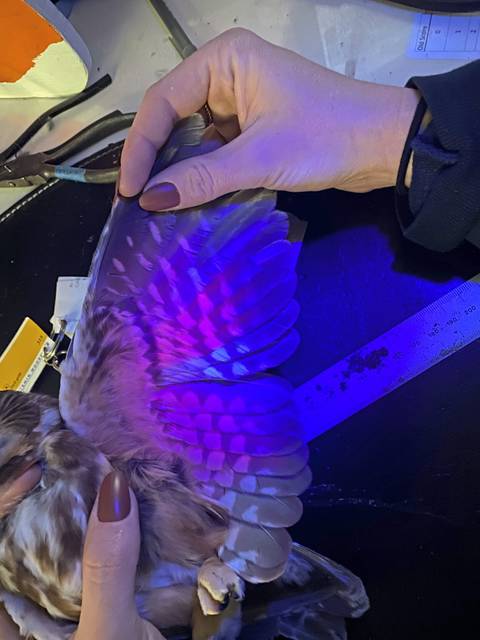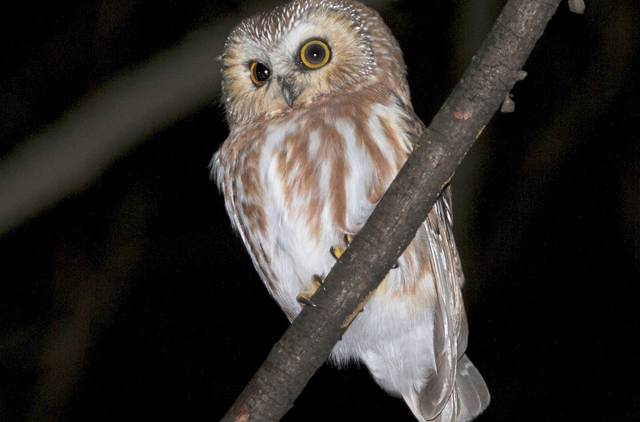Owl be darned — Rockefeller Center Christmas tree survival tale not surprising
It’s actually not unusual, given the circumstances, that a cute Northern saw-whet owl, found in the Christmas Tree at Rockefeller Center recently, is healthy and still adorable.
The saw-whet owl is so named because its call, not the typical hoo-hoo, but rather a mechanical toot-toot, sounds like the sharpening of a saw, a process known as whetting.
The diminutive owl, standing only six to seven inches, is the smallest owl in Pennsylvania, where it is a rare wintering and a very uncommon breeding bird. These owls are on the move now, migrating at night from the northern spruce forests to the southern U.S.
Although it’s a one in a million chance that a Northern saw-whet owl was found in a massive Christmas tree plopped down in New York City, it’s survival is not that unusual given the nature of the bird and the process of ginormous holiday tree harvesting, according to an expert who has been banding these little guys at Sewickley Heights Borough Park for eight years.
“Northern saw-whet owls are very inclined to stay put and that is why our Rockefeller bird ended up wrapped up in a tree,” said Bob Mulvihill, a long-time bird bander who is the ornithologist for the National Aviary. He heads up the only saw-whet owl banding program in the region in an urban area, where he bands each spring and fall when the owls are migrating.
“The owl did not flush because it relies on its camouflage-colored feathers to not be seen,” he said.
Additionally, the process of harvesting massive Christmas trees entails cutting the tree without it crashing to ground, which, had it occurred, would have caused the bird to flush or be injured, he said.
“I’m highly surprised they found the bird,” Mulvihill said. “Kudos to the tree cutters who were very gentle with the tree and, furthermore, to the person who found the owl and safely extricated it. This owl is so tiny; someone was very observant.”
Mulvihill is not surprised that the bird is in good health although it was wrapped up in a 75-foot Norway spruce for several days as the tree was transported from Oneonta, New York, to Rockefeller Center.
“No food or water for two days, that’s almost not an issue for these owls,” said Mulvihill. The bird has quite a bit of fat, which migrant birds need for food. “They don’t drink water like we do,” he added. They get the water they need from food, Mulvihill said.
The birds are famously tame likely because of their lack of exposure to humans and that when they are seen, if they are seen, the saw-whet, like many of its brethren, is sleeping or in low energy mode during the day, Mulvihill said.
An oft-told bird banding story is the unlikely discovery of a saw-whet owl when a bird bander at Presque Isle went into the woods to relieve himself and found one in a stand of trees, at eye level, and took it off a limb and carried it to the other banders to process, he said.
Typically, Mulvihill and a cast of volunteers wait on spring and late autumn nights to catch the birds in fine nets to band them and to learn more about their lives. He has had repeat customers and has discovered birds have wintered in Sewickley Heights park.
One of his more recent catches was an owl banded in southern Alberta, Canada. “That bird showed up in Sewickley, about a 1,500-mile difference,” Mulvihill noted.
Earlier this month, the Carnegie Museum of Natural History’s Powdermill Nature Reserve in Cook, Westmoreland County, caught eight saw-whets.
“They are so stinking cute,” said Annie Lindsay, bird banding program manager. “One of the cool things we did was use black lights to look at the feathers to see how old the birds were.”
The data from Mulvihill’s bird banding at the Sewickley Heights park, which is submitted to a consortium of bird banders tagging saw-whet owls in the United States and Canada, has shown the birds do, indeed, pass through the region and will fly and rest in urban areas where there is green space.
“No one had any idea they were coming through because southwestern Pennsylvania sits in the shadow of Lake Erie,” Mulvihill said of his earlier banding efforts. “The fact we are seeing them repeatedly, south of Erie, clearly shows that the lake is not a barrier to their migration.”
To learn more about Mulvihill’s banding and to potentially observe his banding efforts after the pandemic, visit the Aviary’s Project Owlnet banding station webpage.
The public can symbolically adopt an owl banded by Mulvihill, complete with a certificate, a photo of the owl, the owl’s band number and a fact sheet on the birds vital statistics via the Aviary’s website.
Remove the ads from your TribLIVE reading experience but still support the journalists who create the content with TribLIVE Ad-Free.




